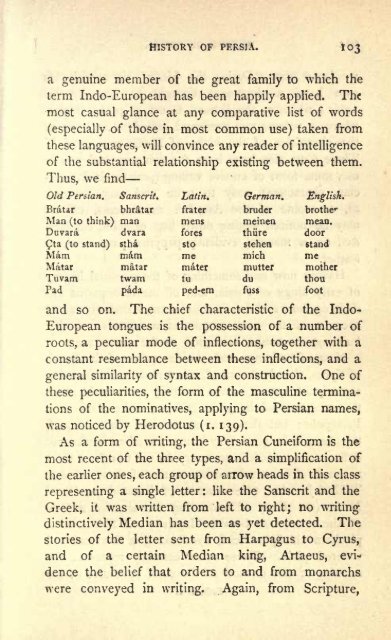Persia from the Earliest Period to the Arab
Persia from the Earliest Period to the Arab
Persia from the Earliest Period to the Arab
You also want an ePaper? Increase the reach of your titles
YUMPU automatically turns print PDFs into web optimized ePapers that Google loves.
HISTORY OF PERSIA. 103<br />
a genuine member of <strong>the</strong> great family <strong>to</strong> which <strong>the</strong><br />
term Indo-European has been happily applied. Th<<br />
most casual glance at any comparative list of words<br />
(especially of those in most common use) taken <strong>from</strong><br />
<strong>the</strong>se languages, will convince any reader of intelligence<br />
of <strong>the</strong> substantial relationship existing between <strong>the</strong>m.<br />
Thus, we find<br />
Old <strong>Persia</strong>n. Sanscrit. Latin. German. English.<br />
Bratar bhratar frater bruder bro<strong>the</strong>'<br />
Man (<strong>to</strong> think) man mens meiuen mean.<br />
Duvara dvara fores thiire door<br />
Cta (<strong>to</strong> stand) stha s<strong>to</strong> stehen stand<br />
Mam mam me mich me<br />
Matar matar mater mutter mo<strong>the</strong>r<br />
Tuvam twam tu du thou<br />
Pad pada ped-em fuss foot<br />
and so on. The chief characteristic of <strong>the</strong> Indo-<br />
of a number of<br />
European <strong>to</strong>ngues is <strong>the</strong> possession<br />
roots, a peculiar mode of inflections, <strong>to</strong>ge<strong>the</strong>r with a<br />
constant resemblance between <strong>the</strong>se inflections, and a<br />
general similarity of syntax and construction. One of<br />
<strong>the</strong>se peculiarities, <strong>the</strong> form of <strong>the</strong> masculine termina-<br />
tions of <strong>the</strong> nominatives, applying <strong>to</strong> <strong>Persia</strong>n names,<br />
was noticed by Herodotus (i. 139).<br />
As a form of writing, <strong>the</strong> <strong>Persia</strong>n Cuneiform is <strong>the</strong><br />
most recent of <strong>the</strong> three types, and a simplification of<br />
<strong>the</strong> earlier ones, each group of arrow heads in this class<br />
representing a single letter: like <strong>the</strong> Sanscrit and <strong>the</strong><br />
Greek, it was written <strong>from</strong> left <strong>to</strong> right; no writing<br />
distinctively Median has been as yet detected. The<br />
s<strong>to</strong>ries of <strong>the</strong> letter sent <strong>from</strong> Harpagus <strong>to</strong> Cyrus,<br />
and of a certain Median king, Artaeus, evi-<br />
dence <strong>the</strong> belief that orders <strong>to</strong> and <strong>from</strong> monarchs<br />
were conveyed in writing. Again, <strong>from</strong> Scripture,

















